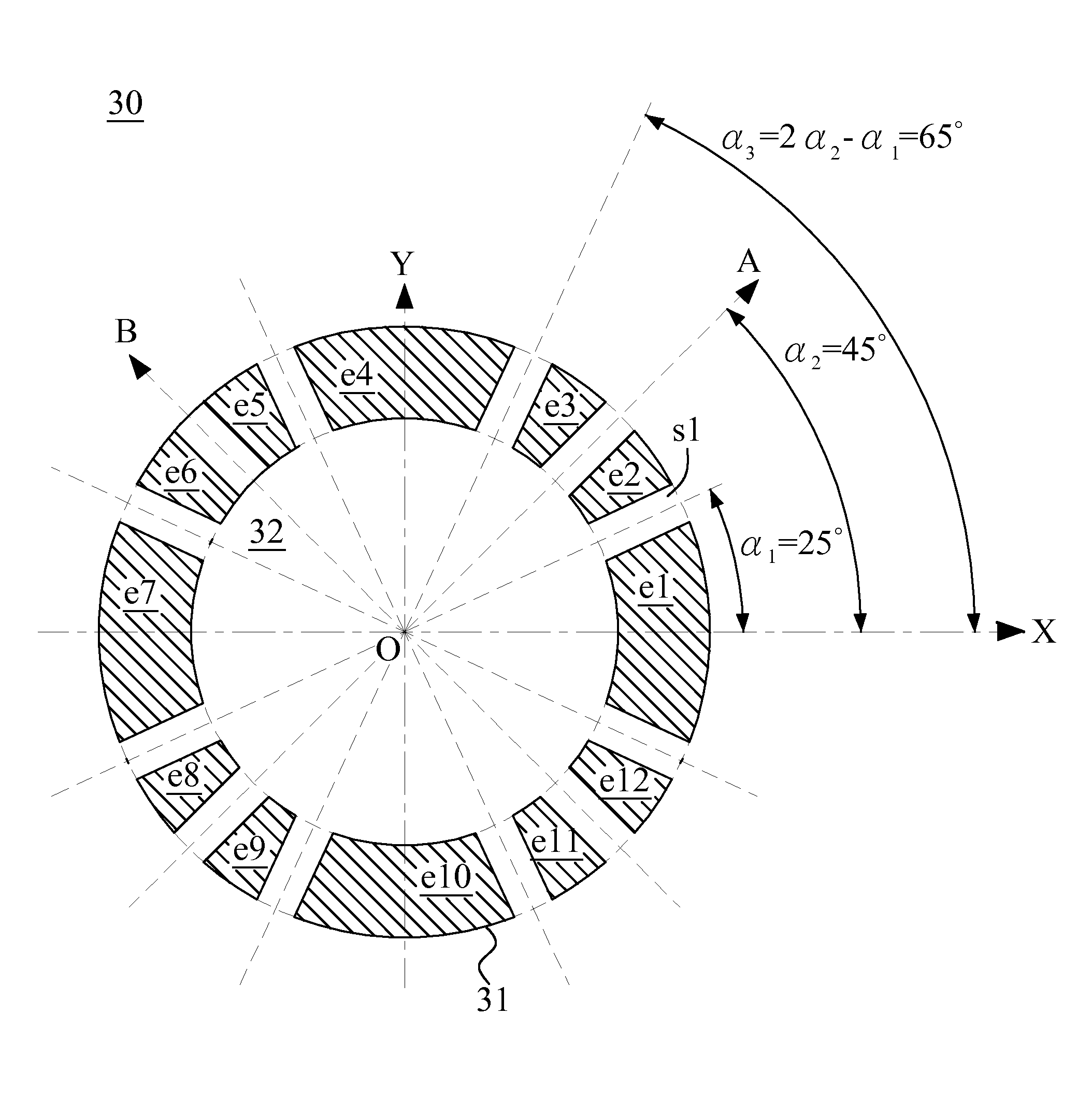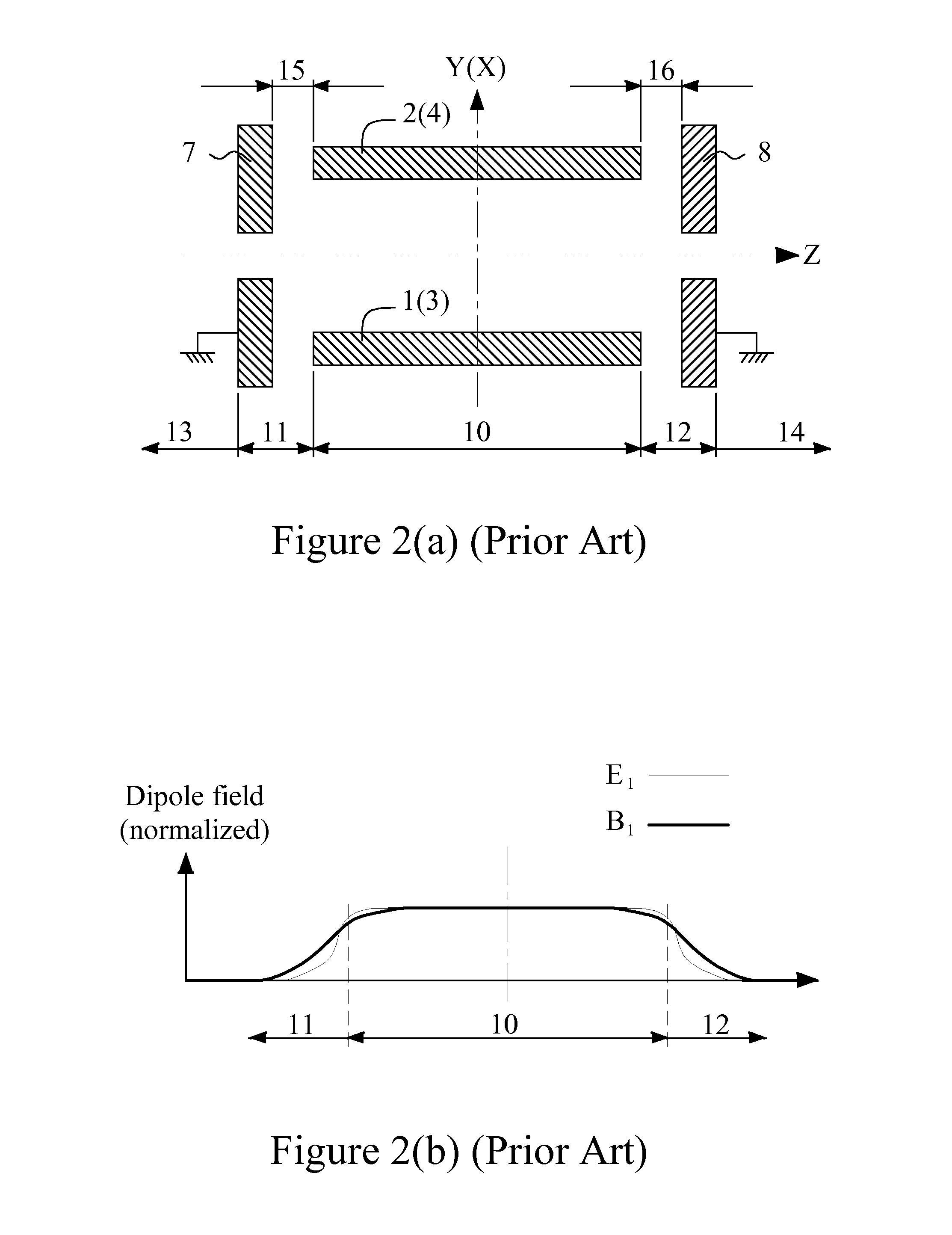Wien filter
a filter and filter body technology, applied in the direction of magnetic discharge control, instruments, beam deviation/focusing by electric/magnetic means, etc., can solve the problems of adding electric and magnetic fields, adding astigmatism to imaging particle beams, adding aberrations to imaging beams, etc., to achieve the effect of compact structure and minimal derivative aberrations
- Summary
- Abstract
- Description
- Claims
- Application Information
AI Technical Summary
Benefits of technology
Problems solved by technology
Method used
Image
Examples
first embodiment
[0057]As the invention, a 12-electrode electric device 30 is proposed and shown in FIGS. 4(a)˜4(f). FIG. 4(a) is the view on a sectional plane perpendicular to the optical axis which lies on Z-axis. The electric device 30 comprises twelve electrodes e1˜e12 named in a counterclockwise rotation sequence. The electrode e1 is on the positive X-axis, and e1˜e12 are respectively named as the 1st˜12th electrodes. The twelve electrodes e1˜e12 are separated by twelve through slits s1˜s12, respectively between every two adjacent electrodes and named in the rotation sequence with respective to electrodes e1˜e12 (here only the 1st through slit s1 between the electrodes e1 and e2 is indicated for the sake of clarity). The inner ends of the twelve electrodes e1˜e12 form a cylindrical through hole 32 and an 8-fold symmetry about four planes XOZ, YOZ, AOZ and BOZ. The plane AOZ is orthogonal to the plane BOZ, and forms an angle equal to 45° with respect to the plane XOZ. The plane XOZ bisects the i...
second embodiment
[0060]As the invention, a cylindrical 4-coil magnetic device is proposed and shown in FIGS. 5(a) and 5(b). The magnetic device 40 comprises four coils c1˜c4 named in a counterclockwise rotation sequence and a cylindrical magnetic core 45 with a cylindrical through hole 46. The central axis of the through hole 46 coincides with Z-axis and is called as the central axis and optical axis of magnetic device 40. FIG. 5(a) is the view on a sectional plane perpendicular to the optical axis on Z-axis. The coils c1˜c4 are respectively winded around the inner sidewall and outer sidewall of the magnetic core 45 in 1st˜4th quadrants, and accordingly named as 1st˜4th coils. The coils c1 and c3 are bisected by the common central plane COZ and the coils c2 and c4 are bisected by the common central plane DOZ, and both of the two common central planes contain the optical axis. The coils c1˜c4 form a 4-fold symmetry about the plane XOZ and the plane YOZ. That means the plane XOZ and the plane YOZ resp...
fourth embodiment
[0063]FIGS. 7(a) and 7(b) show a Wien filter 200 as the invention. FIG. 7(a) is the view on a sectional plane perpendicular to the optical axis of the Wien filter 200. The Wien filter 200 comprises a cylindrical 12-electrode electric device same as shown in FIGS. 4(a)˜4(f) and a cylindrical 4-coil magnetic device 40 same as shown in FIGS. 5(a) and 5(b). In the electric device 30, the outline thereof is configured to be cylindrical and coaxial with the cylindrical through hole 32 thereof. In the magnetic device 40, the cylindrical through hole 46 thereof is configured to be coaxial with the cylindrical outline of the magnetic core 45. The electric device 30 is inside the cylindrical through hole 46 of the magnetic core 45 of the magnetic device 40, and the central axes of both electric device 30 and the magnetic device 40 coincide and are on Z-axis. The central axis of the electric device 30 is called as the optical axis of the Wien filter 200. The 1st electrode e1 of the electric de...
PUM
 Login to View More
Login to View More Abstract
Description
Claims
Application Information
 Login to View More
Login to View More - R&D
- Intellectual Property
- Life Sciences
- Materials
- Tech Scout
- Unparalleled Data Quality
- Higher Quality Content
- 60% Fewer Hallucinations
Browse by: Latest US Patents, China's latest patents, Technical Efficacy Thesaurus, Application Domain, Technology Topic, Popular Technical Reports.
© 2025 PatSnap. All rights reserved.Legal|Privacy policy|Modern Slavery Act Transparency Statement|Sitemap|About US| Contact US: help@patsnap.com



